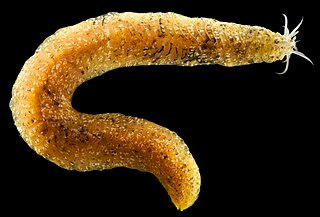
Eulalia viridis is a species of bright-green polychaete worm in the family Phyllodocidae. It can range from 5 to 15 cm in length and is usually found in shallow north Atlantic water under rocks or in mussel beds.

Phyllodoce mucosa is a species of polychaete worm in the family Phyllodocidae. It is found intertidally in both the Pacific and Atlantic Oceans, typically on sandy or muddy seabeds.

Phyllodoce maculata is a species of Polychaete worm in the family Phyllodocidae. It is native to the northeastern Atlantic Ocean where it inhabits shallow water areas of sand, mud and stones.

Phyllodocidae is a family of polychaete worms. Worms in this family live on the seabed and may burrow under the sediment.
Eulalia clavigera is a species of polychaete worm in the family Phyllodocidae, native to the coasts around Britain, through Western France, and to the Iberian Peninsula. It closely resembles Eulalia viridis, and there has been confusion in the past as to the identification of the two species.

Leucia nivea is a species of polychaete worm, commonly known as a "scale worm", in the family Polynoidae. This species occurs in the northeastern Atlantic Ocean, the North Sea and the Mediterranean Sea.
Eunoe spinicirris is a scale worm described from the Sea of Japan at depths of 30–200m.
Hartmania is a genus of marine polychaete worms belonging to the family Polynoidae, the scaleworms. Hartmania contains a single species, Hartmania moorei which is known from the north-west Atlantic Ocean off the coast of North America from shallow water to depths of about 80 m.
Verrucapelma is a genus of marine annelids in the family Polynoidae. Verrucapelma contains three species which are known from shallow water down to a depth of about 90 m. All three species occur in the Indo-Pacific region, in the Coral Sea, northern Australia and the Indonesian archipelago.
Verrucapelma nigricans is a scale worm, known from intertidal habitats in the South China Sea.
Verrucapelma nigricans is a scale worm known from the South China Sea from intertidal habitats.
Verrucapelma retusa is a scale worm known from northern Australia, the Timor Sea and the Coral Sea from shallow water to depths of about 20 m.
Gattyana is a genus of marine annelids in the family Polynoidae. The genus includes 11 species, 9 of which occur in the northern hemisphere, the remaining two are from the Indian Ocean off Mozambique and the Southern Ocean off New Zealand. Species of Gattyana are known from shallow water down to depths of about 1200 m.
Gattyana cirrhosa is a scale worm known from widespread locations in the North Atlantic, Arctic, and northwestern Pacific oceans, from the intertidal zone to depths of at least 1,200 m (3,900 ft).
Gattyana nutti is a scale worm known from the North Atlantic Ocean off the coast of North America at depths down to about 120 m.
Gattyana pohaiensis is a scale worm described from the Yellow Sea at depth down to 26 m.
Gattyana treadwelli is a scale worm known from the north-west Pacific and Arctic Oceans from depths down to about 30 m.
Hermadionella nipponicus is a scale worm known from Japan in the north-west Pacific Ocean from the intertidal zone.
Subadyte papillifera is a scale worm known from the shores of northern Australia and Papua New Guinea from the intertidal zone to depths of about 26 m.

Notophyllum foliosum is a species of annelid in the family Phyllodocidae. Roughly 12 millimeters long, the annelid is bristly and covered in scale-like cirri. The species is found in shallow areas of the seafloor of the Mediterranean, Scandinavia, and Madeira. It was originally described as Phyllodoce foliosa in 1835 and was moved to the genus Notophyllum in 1923. The species was split in two in 2010, with the deeper-dwelling Notophyllum crypticum being designated its own species.






